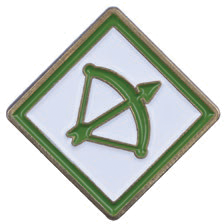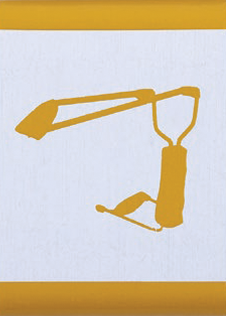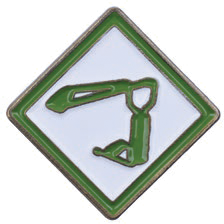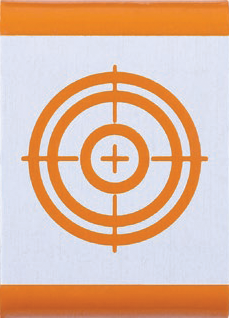| Topic |
Lion |
Tiger |
Wolf |
Bear |
Webelos |
Arrow of Light |
| |
Archery Lion
 
|
Archery Tiger
   
|
Archery Wolf
   
|
Archery Bear
   
|
Archery Webelos
   
|
Archery Arrow of Light
   
|
| Archery Safety Gear |
1. With your Lion adult partner, identify and wear the appropriate safety gear. |
1. With your Tiger adult partner, identify and wear the appropriate safety gear. |
1. Identify and wear the appropriate safety gear. |
1. Identify and wear the appropriate safety gear. |
1. Identify and wear the appropriate safety gear. |
1. Identify and wear the appropriate safety gear. |
| Archery Rules |
2. With your Lion adult partner, recite the archery range safety rules and whistle commands. |
2. With your Tiger adult partner, recite the archery range safety rules and whistle commands. |
2. Demonstrate the archery range safety rules and whistle commands. |
2. Demonstrate the archery range safety rules and whistle commands. |
2. Demonstrate the archery range safety rules and whistle commands. |
2. Demonstrate the archery range safety rules and whistle commands. |
| Archery Commands |
3. With your Lion adult partner, demonstrate proper range commands. |
3. With your Tiger adult partner, demonstrate proper range commands. |
3. Demonstrate proper range commands. |
3. Demonstrate proper range commands. |
3. Demonstrate proper range commands and explain them to an adult or another Scout. |
3. Demonstrate proper range commands and explain them to an adult or another Scout. |
| Archery Equipment |
4. With your Lion adult partner, identify the main parts of your shooting equipment and how to properly use them. |
4. With your Tiger adult partner, identify the main parts of your shooting equipment and how to properly use them. |
4. Identify the main parts of your shooting equipment and how to properly use them. |
4. Identify the main parts of your shooting equipment and how to properly use them. |
4. Identify to main parts of your shooting equipment and how to properly use them. |
4. Identify the main parts of your shooting equipment and how to properly use them. |
| Archery Technique |
5. With your Lion adult partner, demonstrate proper stance and shooting techniques. |
5. With your Tiger adult partner, demonstrate proper stance and shooting techniques. |
5. Demonstrate proper stance and shooting techniques. |
5. Demonstrate proper stance and shooting techniques. |
5. Demonstrate proper stance and shooting techniques. |
5. Demonstrate proper stance and shooting techniques. |
| Archery Shooting |
6. Shoot 2 arrows at your target. Repeat and do your best to improve your score. Shoot at least 4 arrows. |
6.Shoot 3 arrows at your target. Repeat and do your best to improve your score. Shoot at least 6 arrows. |
6. Shoot 5 arrows at your target. Repeat and do your best to improve your score. Shoot at least 10 arrows. |
6. Shoot 5 arrows at a target. Repeat twice and do your best to improve your score each time. Shoot at least 15 arrows. |
6. Following the directions of the range master, shoot at your target. |
6. Shoot 5 arrows at a target. Repeat four times and do your best to improve your score each time. Shoot at least 25 arrows. |
| Archery Retrieval |
7. Demonstrate how to safely retrieve your target arrows. |
7. Demonstrate how to safely retrieve your arrows. |
7. Demonstrate how to safely retrieve your arrows. |
7. Demonstrate how to safely retrieve your arrows. |
7. Demonstrate how to safely retrieve your arrows.Demonstrate how to safely retrieve your arrows. |
7. Demonstrate how to safely retrieve your arrows. |
| |
|
|
|
|
|
|
| |
Slingshot Lion
 
|
|
Slingshot Wolf
 
|
Slingshot Bear
  |
Slingshot Webelos
 
|
Slingshot Arrow of Light
 
|
| Slingshot Safety Gear |
1. With your Lion adult partner, identify and wear the appropriate safety gear.
|
1. With your Tiger adult partner, identify and wear the appropriate safety gear. |
1. Identify and wear the appropriate safety gear. |
1. Identify and wear the appropriate safety gear. |
1. Identify and wear the appropriate safety gear. |
1. Identify and wear the appropriate safety gear. |
| Slingshot Rules |
2. With your Lion adult partner, recite the safety rules for using a slingshot. |
2. With your Tiger adult partner, recite the safety rules for using a slingshot. |
2. Recite the safety rules for using a slingshot. |
2. Recite the safety rules for using a slingshot. |
2. Recite the safety rules for using a slingshot. |
2. Recite the safety rules for using a slingshot. |
| Slingshot Commands |
3. With your Lion adult partner, demonstrate proper range commands. |
3. With your Tiger adult partner, demonstrate proper range commands. |
3. Demonstrate proper range commands. |
3. Demonstrate proper range commands. |
3. Demonstrate proper range commands and explain them to an adult or another Scout. |
3. Demonstrate proper range commands and explain them to an adult or another Scout. |
| Slingshot Equipment |
4. With your Lion adult partner, explore the parts of a slingshot and their usage. |
4. With your Tiger adult partner, explore the parts of a slingshot and their usage. |
4. Explore the parts of a slingshot and their usage. |
4. Explore the parts of a slingshot and their usage
|
4. Explore the parts of a slingshot and their usage. |
4. Explore the parts of a slingshot and their usage. |
| |
5. With your Lion adult partner, discover the types of ammunition that may be used and types that may not be used. |
5. With your Tiger adult partner, discover the types of ammunition that may be used and types that may not be used. |
5. Discover the types of ammunition that may be used and types that may not be used. |
5. Discover the types of ammunition that may be used and types that may not be used. |
5. Discover the types of ammunition that may be used and types that may not be used. |
5. Discover the types of ammunition that may be used and types that may not be used. |
| Slingshot Shooting |
6. Shoot 5 shots at a target. Repeat and do your best to improve your score. Shoot at least 10 shots. |
6. Shoot 5 shots at a target. Repeat and do your best to improve your score. Shoot at least 10 shots. |
6. Shoot 5 shots at a target. Repeat and do your best to improve your score. Shoot at least 10 shots. |
7. Shoot 5 shots at a target. Repeat twice and do your best to improve your score each time. Shoot at least 15 shots. |
7. Shoot 5 shots at a target. Repeat twice and do your best to improve your score each time. Shoot at least 15 shots. |
7. Shoot 5 shots at a target. Repeat twice and do your best to improve your score each time. Shoot at least 15 shots.
8. Following the directions of the range master, shoot at least 5 shots at your target with your non-dominant hand. |
| Slingshot Storage |
7. Demonstrate how to put away and properly store your slingshot and shooting equipment after use. |
7. Demonstrate how to put away and properly store your slingshot and shooting equipment after use. |
7. Demonstrate how to put away and properly store your slingshot and shooting equipment after use. |
8. Demonstrate how to put away and properly store your slingshot and shooting equipment after use. |
8. Demonstrate how to put away and properly store your slingshot and shooting equipment after use.. |
9. Demonstrate how to put away and properly store your slingshot and shooting equipment after use. |
| Slingshot Targets |
|
|
|
6. Discover the types of targets that may be used and types that may not be used. |
6. Discover the types of targets that may be used and types that may not be used. |
6. Discover the types of targets that may be used and types that may not be used. |
| |
|
|
|
|
|
|
| |
|
BB Gun Tiger
   
|
BB Gun Wolf
   
|
BB Guns Bear
   
|
BB Gun Webelos
   
|
BB Gun Arrow of Light
   
|
| BB Gun Safety Gear |
|
1. With your Tiger adult partner, identify and wear the appropriate safety gear. |
1. Identify and wear the appropriate safety gear. |
1. Identify and wear the appropriate safety gear. |
1. Identify and wear the appropriate safety gear. Identify and wear the appropriate safety gear. |
1. Identify and wear the appropriate safety gear. Identify and wear the appropriate safety gear. |
BB Gun
Safety Rules |
|
2. With your Tiger adult partner, recite the 4 safety reminders. With your Tiger adult partner, recite the 4 safety reminders. |
2. Recite the four safety reminders. |
2. Recite the four safety reminders. |
2. Recite the four safety reminders. |
2. Recite the 4 safety reminders. |
BB Gun
Commands |
|
3. With your Tiger adult partner, demonstrate proper range commands. |
3. Demonstrate proper range commands. |
3. Demonstrate proper range commands. |
3. Demonstrate proper range commands and explain them to an adult or another Scout. |
3. Demonstrate proper range commands and explain them to an adult or another Scout. |
| BB Gun Safety Mechanism |
|
4. With your Tiger adult partner, show how to use the safety mechanism. |
4. Show how to use the safety mechanism. |
4. Show how to use the safety mechanism. |
4. Show how to use the safety mechanism. |
4. Show how to use the safety mechanism. |
| BB Gun Equipment |
|
5. With your Tiger adult partner, demonstrate how to properly load, fire, and secure your BB gun. |
5. Demonstrate how to properly load, fire, and secure your BB gun. |
5. Demonstrate how to properly load, fire, and secure your BB gun. |
5. Demonstrate how to properly load, fire, and secure your BB gun. |
5. Demonstrate how to properly load, fire, and secure your BB gun. |
| BB Gun Technique |
|
6. With your Tiger adult partner, demonstrate one of the positions for shooting a BB gun. |
6. Demonstrate one of the positions for shooting a BB gun. |
6. Demonstrate one of the positions for shooting a BB gun. |
6. Demonstrate the prone, bench, and sitting positions for shooting a BB gun. |
6. Demonstrate the prone, bench, and sitting positions for shooting a BB gun. |
| BB Gun Shooting |
|
7. Fire 5 BBs at the target. With the help of your Tiger adult partner, score your target. Repeat and do your best to improve your score. Fire at least 10 BBs. |
7. Fire 5 BBs at the target and score your target. Repeat twice and do your best to improve your score. Fire at least 15 BBs. |
7. Fire 5 BBs at the target and score your target. Repeat twice and do your best to improve your score. Fire at least 15 BBs. |
7. Fire 5 BBs at the target and score your target. Repeat three times and do your best to improve your score. Fire at least 20 BBs. |
7. Fire 5 BBs at the target and score your target. Repeat three times and do your best to improve your score. Fire at least 20 BBs. |
| BB Gun Storage |
|
8. Demonstrate how to put away and properly store your BB gun and shooting equipment after use. |
8. Demonstrate how to put away and properly store your BB gun and shooting equipment after use. |
8. Demonstrate how to put away and properly store your BB gun and shooting equipment after use. |
8. Demonstrate how to put away and properly store your BB gun and shooting equipment after use. |
8. Demonstrate how to put away and properly store your BB gun and shooting equipment after use. |